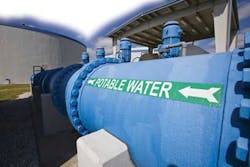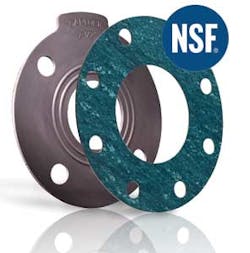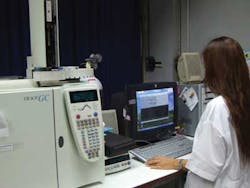Sealing the Deal: Qualifying Sealing Materials for Potable Water Systems
By Michael P. McNally
There are numerous potential sources of contamination in potable water systems, not least of which is contact with the components comprising these systems. On its journey from the source to the tap, water typically passes through miles of pipe and various mechanical devices such as pumps, meters, and valves, all of which require seals.
The U.S. Environmental Protection Agency (EPA) prescribes potable water quality standards in its National Primary Drinking Water Regulations (40 CFR 141). To ensure water is fit for human consumption, use of materials that may leach hazardous substances into these systems must be avoided. To meet this objective requires a wide range of sealing materials.
Because of their resilient properties, elastomers account for a large portion of these materials. Compounds of natural (NR), styrene butadiene (SBR), and acrylonitrile butadiene (NBR) rubbers and Chloroprene (Neoprene [CR]) have been used for decades for pipe seals, gate valves, flange gaskets and O-rings.
Ethylene propylene diene rubber (EPDM), with its superior hydrolytic stability and resistance to chloramines, is becoming more widely used in these applications. Even fluoroelastomers (FKM) are being used in gaskets for CPVC piping, where leaching of plasticizers from other elastomers can compromise the piping.
Rubber-bound fiber sheet finds application in a variety of flange gaskets where, because of limitations on size or gasket stress, homogenous elastomers cannot be used. Polytetrafluoroethylene (PFTE) based materials are used in applications where chemical resistance or high levels of purity are required. Glass fiber reinforced epoxy (GRE) is widely used in gaskets where mating flanges must be electrically isolated (Figure 3).
It is important to note not all gaskets, seals and diaphragms are made of materials that have been scientifically proven not to leach out substances in quantities that could be harmful.
NSF/ANSI Standard 61 Drinking Water System Components - Health Effects establishes minimum health effects requirements for materials, components, products, or systems that contact drinking water, drinking water treatment chemicals, or both. However it does not address all aspects of product use. Some items not addressed by this standard are performance, taste and odor, and microbiological growth support. The NSF certification process involves seven basic steps:
Application: Disclosure by the manufacturer of all water-contact materials in the product, plus disclosure by the manufacturer's suppliers of all chemical ingredients in the materials is required. For some sealing products such as compressed fiber sheet that may contain a dozen or more ingredients from multiple suppliers, this can be a lengthy process. The application requires the manufacturer to provide not only the trade name and information on the various ingredients, but also the chemical nomenclature, chemical abstract service (CAS) number, and its percentage of the composition.
Formulation, toxicology and product use: Both the user and suppliers complete and submit the NSF product information form, including formulation, toxicology and product use. This involves supplying material safety data sheets (MSDS) for all of the ingredients, along with a description of how the product will be used and what parts of it will be in contact with the water.
NSF formulation review: NSF toxicologists conduct a formulation review of each water-contact material to determine if there are any ingredients, contaminants, or reaction by-products that could potentially leach from the material into drinking water. This review in turn determines the battery of chemical analyses that will be performed on a particular material. If adequate information cannot be obtained from the safety data sheets, NSF will request from the supplier full disclosure of all the substances making up the ingredient. Although this information is supplied directly to NSF and is kept confidential, some suppliers will not provide it. In this case, the ingredient cannot be used in the product.
Plant audit and sample collection: NSF then inspects the production facility to verify the product formulation and production process and to ensure that adequate quality control procedures are in place to prevent the use of unauthorized materials. In addition, product samples are collected and sent to NSF laboratories to be tested to the appropriate exposure protocol of NSF/ANSI Standard 61.
Laboratory testing: Materials and devices are evaluated according to the exposure and analysis methods in Annex B of NSF/ANSI Standard 61. Most products undergo a three-week process, whereby they are exposed to variously formulated waters designed to extract specific types of contaminants. Contaminant concentrations are then determined from chemical analyses of the exposed water samples.
The test methods and analytical instrumentation used depend upon the material being tested. Instrumentation includes gas chromatography (GC), gas chromatography/mass spectroscopy (GC/MS), graphite furnace atomic absorption spectrophotometry (GFAA), inductively coupled plasma (ICP), inductively coupled plasma/mass spectroscopy (ICP/MS), liquid chromatography/mass spectroscopy (LC/MS), high-performance liquid chromatography (HPLC), high-resolution gas chromatography/mass spectroscopy (GCMS), total organic carbon (TOC) and ion chromatography (IC). Many of the test methods are based on EPA test protocols.
There are minimum test requirements called out for various materials. Depending on the formulation, additional testing may be required. Typically this involves testing for metals using ICP/MS.
Toxicology evaluation: Contaminant concentrations are then evaluated by a toxicologist to pass/fail criteria in Annex D and E of NSF/ANSI Standard 61. Products that meet the requirements of the standard are certified and appear in the NSF Listings.
If a product fails to meet these requirements, the manufacturer may identify the source of the failure and submit a reformulated product for certification.
Follow-up program: Once products are certified and listed by NSF, they are inspected and reviewed on an annual basis. Listed production facilities are subjected to unannounced annual inspections by NSF auditors to ensure that certified products are made according to the authorized formulations and processes. Products are collected on a routine basis for retesting.
If a certified product fails the retest, NSF immediately notifies the manufacturer, requiring shipment of the noncompliant product to be halted and the cause of the failure to be fully investigated; an NSF field auditor inspects the facility to ensure the manufacturer has taken these steps. If the manufacturer is able to identify and correct the cause of the failure, the product may be resubmitted for certification. If the reformulated product meets the requirements of NSF/ANSI Standard 61, the manufacturer may again mark and sell it as NSF certified.
NSF Certification Marks
Packages, containers, materials and individual products certified as drinking water system components bear the NSF Mark either directly above or directly next to the certification statement "Certified to NSF/ANSI 61". This statement is not required to be enclosed in a box.
The cost of certification and follow up can exceed $10,000 plus annual fees approaching the initial cost. However NSF fees are only part of the cost; as noted, considerable time and effort are required on the part of the manufacturer to provide the necessary information. Also to be considered is the fact that not all certification projects are successful; therefore seal manufacturers often conduct extensive research, performing various screening tests prior to initiating the process. Although manufacturers of mechanical devices seeking NSF-61 certification are not required to use previously certified sealing components, it is recommended to do so.
NSF 61 Annex G & NSF 372
Federal efforts to control lead concentrations in drinking water began in 1974 with the passage of the Safe Drinking Water Act (SDWA). Under the act, potable water system components must qualify as being lead-free by complying with federal requirements. In January 2011, the Reduction of Lead in Drinking Water Act defined stricter requirements by reducing the maximum content levels for compliance. These provisions will take effect in January 2014.
Currently the NSF 61 standard limits the maximum allowable amounts of various elements and compounds that are leached out of a product under specified conditions. Annex G (NSF 61G) specifies the amount of lead a product may contain, whether it leaches out or not. The test protocol for the testing of lead in a product is specified in NSF 372. Annex G of NSF 61 contains an optional method for determining weighted average lead content of <0.25%, which is now required in some states.
From the perspective of the seal user, it is extremely important to not only understand these applicable compliance requirements, but to also ensure that they are being met. Compliance is a legal requirement in many states, provinces and countries. As evidenced by issues with other products that come into human contact either directly or indirectly, use of sealing materials that are either unsafe or not recognized as being safe can have significant adverse consequences.
About the Author: Michael McNally is the senior chemist at Garlock Sealing Technologies. He has over 40 years of experience in analytical chemistry, materials engineering and product compliance. He may be reached at [email protected]
WaterWorld Articles Archives






